140 search results - page 5 / 28 » Mesh Reduction with Error Control |
SMA
2009
ACM
14 years 1 months ago
2009
ACM
Current mesh reduction techniques, while numerous, all primarily reduce mesh size by successive element deletion (e.g. edge collapses) with the goal of geometric and topological f...
SGP
2003
13 years 8 months ago
2003
Any quantization introduces errors. An important question is how to suppress their visual effect. In this paper we present a new quantization method for the geometry of 3D meshes,...
TASLP
2010
13 years 2 months ago
2010
This paper presents a weighted approach for integrated active noise control and noise reduction in hearing aids. An integrated scheme has been introduced previously to tackle seco...
APSEC
2009
IEEE
14 years 2 months ago
2009
IEEE
— This paper describes a controlled experiment of student programmers performing maintenance tasks on a C++ program. The goal of the study is to assess the maintenance size, effo...
CG
2008
Springer
13 years 7 months ago
2008
Springer
Many graphics applications represent deformable surfaces through dynamic meshes. To be consistent during deformations, the dynamic meshes require an adaptation process. In this pa...

